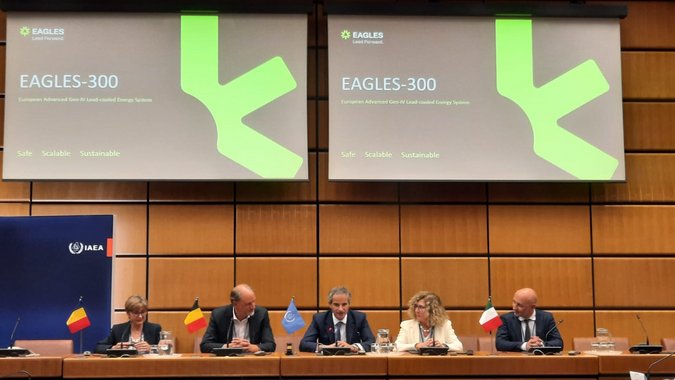During a signing ceremony the EAGLES Consortium and the nuclear regulators of Belgium (FANC), Italy (ISIN), and Romania (CNCAN) officially kicked off an international pre-licensing initiative for the EAGLES-300 reactor. As the first pilot project under the Nuclear Harmonization and Standardization Initiative (NHSI) of the IAEA, this milestone represents an important step toward cross-border harmonization of nuclear safety regulations. IAEA Director General Rafael Mariano Grossi, Minister of Energy Mathieu Bihet, and Minister of Security and Interior Bernard Quintin attended the signing ceremony in person.
Harmonization to accelerate global deployment
SMRs are designed for global deployment and to become available more quickly through serial production. Yet today, each country still applies its own nuclear safety rules and licensing procedures. These different national rules and procedures may require developers to go through separate licensing processes in every country, making it harder to benefit from the scalability of SMRs. And that is precisely where international harmonization can make the difference.
The EAGLES-300 pre-licensing project is a first-of-a-kind initiative. Never before have national regulators collaborated so early in the development process of an advanced small modular reactor. By aligning safety standards and regulatory expectations early, while fully respecting national responsibilities, the EAGLES pre-licensing project aims to reduce duplication, clarify requirements, and accelerate the safe worldwide deployment of advanced SMRs.
The IAEA supports the project within its NHSI Regulatory Track. NHSI aims to align regulatory practices across borders, making it easier to license and deploy innovative reactor designs like EAGLES-300 efficiently and safely. Through this coordinated effort, the consortium is already laying the groundwork for the future of advanced nuclear energy.
“Our support of this pre-licensing joint review effort is a natural next step of the IAEA’s Nuclear Harmonization and Standardization Initiative (NHSI), which is helping to ensure SMRs move from development to deployment in a safe and timely way,” said Rafael Mariano Grossi, Director General of IAEA, adding: “Almost every day the IAEA gets inquiries about when SMRs will be available. From developing countries looking to power growing electricity grids to technology companies needing electricity for AI data centres, the need for low-carbon, reliable nuclear energy in the form of SMRs is there and the IAEA is at the center of the international effort to make sure this demand can be met, with due consideration for safety, security and safeguards.”
Lead-cooled SMRs: flexible, sustainable, scalable
EAGLES-300 is a lead-cooled SMR with an electrical output of about 300 MWe. Its modular design enables faster construction, lower investment costs and flexible deployment. Beyond electricity, it can provide heat for industrial applications and hydrogen production. An advanced fuel strategy, including the use of recycled materials, enhances sustainability, reduces radioactive waste and improves resource efficiency.
"We are technically and scientifically on track. With our two key test facilities, LEANDREA and ALFRED, we will work step by step towards the commercialization of the EAGLES-300 in 2039 and its broad rollout. Taking this pre-licensing step now is therefore a crucial milestone on the road towards commercialization, just two months after our foundation," says the EAGLES Consortium.
What is pre-licensing?
Pre-licensing is a structured, exploratory process that allows nuclear regulators and technology developers to engage in early dialogue – before a formal licensing application is submitted. It’s not about granting approval, but about building mutual understanding of safety expectations, technical challenges, and regulatory frameworks.
For advanced technologies like lead-cooled SMRs, pre-licensing helps identify potential issues early and supports a more efficient, better-informed licensing process later on. The approach is typically top-down: starting from high-level safety principles and gradually moving toward more detailed technical discussions.
In the next phase, licensing becomes a formal process. Each national regulator assesses whether the reactor design meets all legal and technical requirements for safety, security, radiation protection, and environmental impact.
Strong EAGLES presence on the opening day of the IAEA General Conference
The launch of the EAGLES-300 pre-licensing pilot was one of several EAGLES activities during the first day of the IAEA’s 69th General Conference. At the EU Member States Area, the consortium hosted a one-day stand showcasing the EAGLES-300 project and its role as a pilot under NHSI’s Regulatory Track. The stand attracted interest from stakeholders across the nuclear sector.
A dedicated EAGLES side event titled “EAGLES: Towards a European Advanced Lead-Cooled Small Modular Reactor” featured panel discussions with Steering Committee members, national regulators, and NHSI/IAEA representatives. The event attracted a large audience, highlighting growing interest in harmonized approaches to advanced nuclear technologies and the consortium’s long-term vision.
About the EAGLES Consortium
EAGLES Consortium is a strategic partnership between Ansaldo Nucleare, ENEA, RATEN-ICN, and SCK CEN, aimed at developing the EAGLES-300 Small Modular Reactor (SMR) by 2039. This alliance represents a unique collaboration between European industrial leaders and nuclear research institutions. Unlike purely research-based initiatives, all the activities of the Consortium will be focused on commercialization, ensuring a clear path from research and development to market deployment. Focused on advanced lead-cooled fast reactor technology, the EAGLES Consortium is committed to delivering EAGLES-300, a commercially viable nuclear solution for the future.





